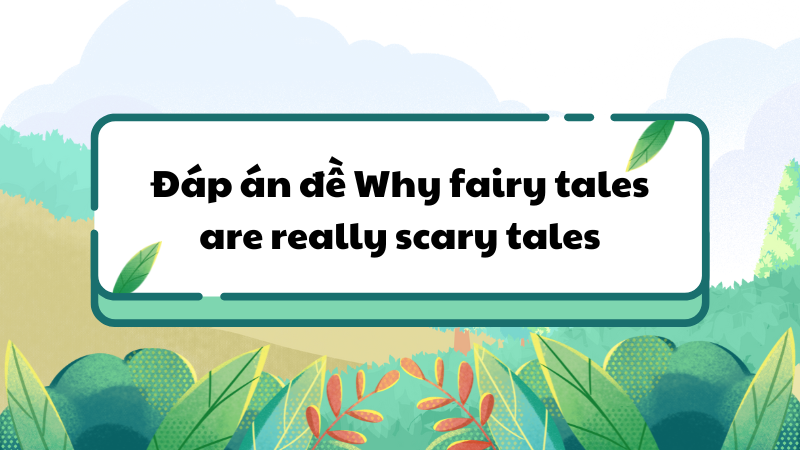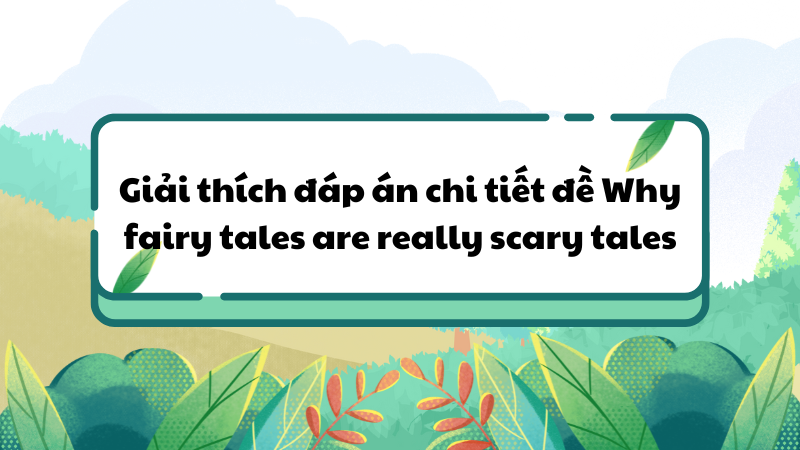Why fairy tales are really scary tales là bài đọc xuất hiện trong Đề Cam 15, Test 3, Reading passage 3, tại bài viết dưới đây, hãy cùng Edmicro xem qua đáp án cũng như giải thích đáp án cho từng câu:
Đề bài
Why fairy tales are really scary tales
Some people think that fairy tales are just stories to amuse children, but their universal and enduring appeal may be due to more serious reasons
People of every culture tell each other fairy tales but the same story often takes a variety of forms in different parts of the world. In the story of Little Red Riding Hood that European children are familiar with, a young girl on the way to see her grandmother meets a wolf and tells him where she is going. The wolf runs on ahead and disposes of the grandmother, then gets into bed dressed in the grandmother’s clothes to wait for Little Red Riding Hood. You may think you know the story – but which version? In some versions, the wolf swallows up the grandmother, while in others it locks her in a cupboard. In some stories Red Riding Hood gets the better of the wolf on her own, while in others a hunter or a woodcutter hears her cries and comes to her rescue.The universal appeal of these tales is frequently attributed to the idea
that they contain cautionary messages: in the case of Little Red Riding Hood, to listen to your mother, and avoid talking to strangers. ‘It might be what we find interesting about this story is that it’s got this survival- relevant information in it,’ says anthropologist Jamie Tehrani at Durham University in the UK. But his research suggests otherwise. ‘We have this huge gap in our knowledge about the history and prehistory of storytelling, despite the fact that we know this genre is an incredibly ancient one,’ he says. That hasn’t stopped anthropologists, folklorists” and other academics devising theories to explain the importance of fairy tales in human society. Now Tehrani has found a way to test these ideas, borrowing a technique from evolutionary biologists.
To work out the evolutionary history, development and relationships among groups of organisms, biologists compare the characteristics of living species in a process called ‘phylogenetic analysis’. Tehrani has used the same approach to compare related versions of fairy tales to discover how they have evolved and which elements have survived longest.
Tehrani’s analysis focused on Little Red Riding Hood in its many forms, which include another Western fairy tale known as The Wolf and the Kids. Checking for variants of these two tales and similar stories from Africa, East Asia and other regions, he ended up with 58 stories recorded from oral traditions. Once his phylogenetic analysis had established that they were indeed related, he used the same methods to explore how they have developed and altered over time.
First he tested some assumptions about which aspects of the story alter least as it evolves, indicating their importance. Folklorists believe that what happens in a story is more central to the story than the characters in it – that visiting a relative, only to be met by a scary animal in disguise, is more fundamental than whether the visitor is a little girl or three siblings, or the animal is a tiger instead of a wolf.
However, Tehrani found no significant difference in the rate of evolution of incidents compared with that of characters. ‘Certain episodes are very stable because they are crucial to the story, but there are lots of other details that can evolve quite freely,’ he says. Neither did his analysis support the theory that the central section of a story is the most conserved part. He found no significant difference in the flexibility of events there compared with the beginning or the end.
But the really big surprise came when he looked at the cautionary elements of the story. ‘Studies on hunter-gatherer folk tales suggest that these narratives include really important information about the environment and the possible dangers that may be faced there – stuff that’s relevant to survival,’ he says. Yet in his analysis such elements were just as flexible as seemingly trivial details. What, then, is important enough to be reproduced from generation to generation?
The answer, it would appear, is fear – blood-thirsty and gruesome aspects of the story, such as the eating of the grandmother by the wolf, turned out to be the best preserved of all. Why are these details retained by generations of storytellers, when other features are not? Tehrani has an idea: ‘In an oral context, a story won’t survive because of one great teller. It also needs to be interesting when it’s told by someone who’s not necessarily a great storyteller.’ Maybe being swallowed whole by a wolf, then cut out of its stomach alive is so gripping that it helps the story remain popular, no matter how badly it’s told.
Jack Zipes at the University of Minnesota, Minneapolis, is unconvinced by Tehrani’s views on fairy tales. ‘Even if they’re gruesome, they won’t stick unless they matter,’ he says. He believes the perennial theme of women as victims in stories like Little Red Riding Hood explains why they continue to feel relevant. But Tehrani points out that although this is often the case in Western versions, it is not always true elsewhere. In Chinese and Japanese versions, often known as The Tiger Grandmother, the villain is a woman, and in both Iran and Nigeria, the victim is a boy.
Mathias Clasen at Aarhus University in Denmark isn’t surprised by Tehrani’s findings. ‘Habits and morals change, but the things that scare us, and the fact that we seek out entertainment that’s designed to scare us – those are constant,’ he says. Clasen believes that scary stories teach us what it feels like to be afraid without having to experience real danger, and so build up resistance to negative emotions.
Questions 27-31
Complete each sentence with the correct ending, A-F, below.
Write the correct letter, A-F, in boxes 27-31 on your answer sheet.
27 – In fairy tales, details of the plot
28 – Tehrani rejects the idea that the useful lessons for life in fairy tales
29 – Various theories about the social significance of fairy tales
30 – Insights into the development of fairy tales
31 – All the fairy tales analysed by Tehrani
| A. may be provided through methods used in biological research. B. are the reason for their survival. C. show considerable global variation. D. contain animals which transform to become humans. E. were originally spoken rather than written. F. have been developed without factual basis. |
Questions 32-36
Complete the summary using the list of words, A-I, below.
Write the correct letter, A-I, in boxes 32-36 on your answer sheet.
Phylogenetic analysis of Little Red Riding Hood
Tehrani used techniques from evolutionary biology to find out if 32..…………………….. existed among 58 stories from around the world. He also wanted to know which aspects of the stories had fewest 33………………………, as he believed these aspects would be the most important ones. Contrary to other beliefs, he found that some 34.……………………..that were included in a story tended to change over time, and that the middle of a story seemed no more important than the other parts. He was also surprised that parts of a story which seemed to provide some sort of 35……………………… were unimportant. The aspect that he found most important in a
story’s survival was 36………………………..
| A. ending | B. events | C. warning |
| D. links | E. records | F. variations |
| G. horror | H. people | I. plot |
Questions 37-40
Choose the correct letter, A, B, C or D.
Write the correct letter in boxes 37-40 on your answer sheet.
37 – What method did Jamie Tehrani use to test his ideas about fairy tales?
A. He compared oral and written forms of the same stories.
B. He looked at many different forms of the same basic story.
C. He looked at unrelated stories from many different countries.
D. He contrasted the development of fairy tales with that of living creatures.
38 – When discussing Tehrani’s views, Jack Zipes suggests that
A. Tehrani ignores key changes in the role of women.
B. stories which are too horrific are not always taken seriously.
C. Tehrani overemphasises the importance of violence in stories.
D. features of stories only survive if they have a deeper significance.
39 – Why does Tehrani refer to Chinese and Japanese fairy tales?
A. to indicate that Jack Zipes’ theory is incorrect
B. to suggest that crime is a global problem
C. to imply that all fairy tales have a similar meaning
D. to add more evidence for Jack Zipes’ ideas
40 – What does Mathias Clasen believe about fairy tales?
A. They are a safe way of learning to deal with fear.
B. They are a type of entertainment that some people avoid.
C. They reflect the changing values of our society.
D. They reduce our ability to deal with real-world problems.
Đáp án đề Why fairy tales are really scary tales
Các bạn có thể tham khảo đáp án đề Why fairy tales are really scary tales ở bảng dưới đây nhé!

| Câu hỏi | Đáp án |
|---|---|
| 27 | C |
| 28 | B |
| 29 | F |
| 30 | A |
| 31 | E |
| 32 | D |
| 33 | F |
| 34 | B |
| 35 | C |
| 36 | G |
| 37 | B |
| 38 | D |
| 39 | A |
| 40 | A |
Xem thêm: IELTS Recent Actual Test: Tuyển Tập Đề Thi Thử IELTS
Giải thích đáp án chi tiết đề Why fairy tales are really scary tales

Câu 27 – 31
- Câu 27
Đáp án: C
Dạng câu hỏi: Matching Sentence Endings
Vị trí đáp án: Đoạn 1, Câu 1
Giải thích đáp án: Câu “People of every culture tell each other fairy tales but the same story often takes a variety of forms in different parts of the world.”, kết luận rằng các chi tiết cốt truyện trong truyện cổ tích là khác nhau trên toàn cầu (different parts of the world). Do đó, câu trả lời là C (show considerable global variation.).
- Câu 28
Đáp án: B
Dạng câu hỏi: Matching Sentence Endings
Vị trí đáp án: Đoạn 2, Câu 2- Câu 3
Giải thích đáp án: Trong vị trí được trích dẫn, có ghi “It might be what we find interesting about this story is that it’s got this survival-relevant information in it,’ says anthropologist Jamie Tehrani at Durham University in the UK. But his research suggests otherwise.”. Dựa vào câu này, có thể suy ra rằng nghiên cứu của Tehrani cho thấy sự tồn tại của những câu chuyện cổ tích không phải là do những bài học mà chúng truyền đạt. Do đó, câu trả lời là B (are the reason for their survival.).
- Câu 29
Đáp án: F
Dạng câu hỏi: Matching Sentence Endings
Vị trí đáp án: Đoạn 2, Câu 4-Câu 5
Giải thích đáp án: Trong Đoạn 2, có nêu rằng “We have this huge gap in our knowledge about the history and prehistory of storytelling…That hasn’t stopped anthropologists, folklorists* and other academics devising theories to explain the importance of fairy tales in human society.”. Câu phát biểu này chỉ ra rằng mặc dù có khoảng cách giữa các sự kiện kể chuyện, nhiều lý thuyết khác nhau đã được các nhà nhân chủng học, nhà nghiên cứu văn hóa dân gian và các học giả khác phát triển về tầm quan trọng của truyện cổ tích. Do đó, câu trả lời là F (have been developed without factual basis.).
- Câu 30
Đáp án: A
Dạng câu hỏi: Matching Sentence Endings
Vị trí đáp án: Đoạn 3, Câu 1-Câu 2
Giải thích đáp án: Trong vị trí được trích dẫn, có nêu rằng “…biologists compare the characteristics of living species in a process called ‘phylogenetic analysis’. Tehrani has used the same approach to compare related versions of fairy tales…”. Dựa trên tài liệu tham khảo này, có thể kết luận rằng Tehrani sử dụng một phương pháp sinh học gọi là ‘phân tích phát sinh loài’ để có được hiểu biết sâu sắc về sự phát triển của truyện cổ tích. Do đó, câu trả lời là A (may be provided through methods used in biological research.).
Xem thêm: Collins Reading For IELTS [PDF]: Chinh Phục IELTS Reading
- Câu 31
Đáp án: E
Dạng câu hỏi: Matching Sentence Endings
Vị trí đáp án: Đoạn 3, Câu 3-Câu 4
Giải thích đáp án: Các Đoạn trích dẫn của đoạn thứ ba cho chúng ta biết “Tehrani’s analysis focused on Little Red Riding Hood in its many forms …he ended up with 58 stories recorded from oral traditions.”. Vì vậy, có thể kết luận rằng những câu chuyện mà Tehrani phân tích là những câu chuyện được kể (ghi lại từ truyền thống truyền miệng). Do đó, câu trả lời là E (were originally spoken rather than written.).
Câu 32 – 36
- Câu 32
Đáp án: D
Dạng câu hỏi: Summary Completion
Vị trí đáp án: Đoạn 3, Câu 5
Giải thích đáp án: Đoạn đã cho nêu rõ rằng “Once his phylogenetic analysis had established that they were indeed related, he used the same methods to explore how they have developed and altered over time.”. Điều này chỉ ra rằng Tehrani đã sử dụng một kỹ thuật sinh học gọi là phân tích phát sinh loài để tìm hiểu xem 58 câu chuyện mà ông phân tích có liên quan (có bất kỳ liên kết nào không). Do đó, câu trả lời là D (links).
- Câu 33
Đáp án: F
Dạng câu hỏi: Summary Completion
Vị trí đáp án: Đoạn 4, Câu 1
Giải thích đáp án: Trong đoạn thứ tư, có ghi “First, he tested some assumptions about which aspects of the story alter least as it evolves, indicating their importance.”. Tài liệu tham khảo này chứng minh rằng Tehrani đã cố gắng tìm ra các phần của câu chuyện có ít thay đổi nhất (thay đổi) vì đó là những phần quan trọng nhất. Do đó, câu trả lời là F (variations).
- Câu 34
Đáp án: B
Dạng câu hỏi: Summary Completion
Vị trí đáp án: Đoạn 4, Câu 2 & Đoạn 5, Câu 1
Giải thích đáp án: Trong dòng trích dẫn, có viết rằng “Folklorists believe that what happens in a story is more central to the story than the characters in it…However, Tehrani found no significant difference in the rate of evolution of incidents compared with that of characters.”. Có thể kết luận rằng trái ngược với niềm tin chung của các nhà nghiên cứu văn học dân gian rằng phần giữa của câu chuyện quan trọng hơn, Tehrani phát hiện ra rằng một số sự kiện (biến cố) thay đổi và phần trung tâm không quan trọng lắm. Do đó, câu trả lời là B (events).
- Câu 35
Đáp án: C
Dạng câu hỏi: Summary Completion
Vị trí đáp án: Đoạn 5, Câu 5 & Câu 7
Giải thích đáp án: Ở vị trí được đưa ra, có ghi rằng “But the really big surprise came when he looked at the cautionary elements of the story…Yet in his analysis such elements were just as flexible as seemingly trivial details.”. Điều này cho thấy Tehrani đã rất ngạc nhiên khi phát hiện ra các cảnh báo (các yếu tố cảnh báo) lại linh hoạt và không quá quan trọng (cautionary elements) lại linh hoạt và không quá quan trọng (trivial details). Do đó, câu trả lời là C (warning).
- Câu 36
Đáp án: G
Dạng câu hỏi: Summary Completion
Vị trí đáp án: Đoạn 5, Câu 8 & Đoạn 6, Câu 1
Giải thích đáp án: Trong các đoạn văn được chỉ định, có nêu rằng “What, then, is important enough to be reproduced from generation to generation? The answer, it would appear, is fear – blood-thirsty and gruesome aspects of the story…”. Điều này cho thấy Tehrani đã phát hiện ra rằng yếu tố quan trọng nhất của các câu chuyện là sự kinh hoàng (khía cạnh khát máu và ghê rợn). Do đó, câu trả lời là G (horror).
Câu 37 – 40
- Câu 37
Đáp án: B
Dạng câu hỏi: Multiple-Choice Questions
Vị trí đáp án: Đoạn 3, Câu 3
Giải thích đáp án: Ở vị trí được đề cập, có ghi rằng “Tehrani’s analysis focused on Little Red Riding Hood in its many forms, which include another Western fairy tale known as The Wolf and the Kids.”. ói cách khác, Tehrani đã phân tích nhiều phiên bản khác nhau (nhiều) của cùng một câu chuyện. Do đó, câu trả lời là B (He looked at many different forms of the same basic story.).
- Câu 38
Đáp án: D
Dạng câu hỏi: Multiple-Choice Questions
Vị trí đáp án: Đoạn 7, Câu 2
Giải thích đáp án:Trong đoạn thứ bảy, có nêu rõ rằng “‘Even if they’re gruesome, they won’t stick unless they matter,’ he says.”. Nói cách khác, Jack Zipes cho rằng nếu những câu chuyện không có ý nghĩa sâu sắc hơn (chúng có ý nghĩa), chúng sẽ không tồn tại (sẽ không tồn tại). Do đó, câu trả lời là D (features of stories only survive if they have a deeper significance. ).
- Câu 39
Đáp án: A
Dạng câu hỏi: Multiple-Choice Questions
Vị trí đáp án: Đoạn 7, Câu 4-Câu 5
Giải thích đáp án: Trong đoạn văn nêu trên, có nêu rằng “But Tehrani points out that although this is often the case in Western versions, it is not always true elsewhere. In Chinese and Japanese versions, often known as The Tiger Grandmother…”. Có thể chỉ ra rằng Tehrani tham khảo phiên bản tiếng Trung và tiếng Nhật của các câu chuyện để chứng minh rằng ý kiến của Jack Zipes là không đúng. Do đó, câu trả lời là A (to indicate that Jack Zipes’ theory is incorrect).
- Câu 40
Đáp án: A
Dạng câu hỏi: Multiple-Choice Questions
Vị trí đáp án: Đoạn 7, Câu 8
Giải thích đáp án: Trong dòng có đề cập rằng “Clasen believes that scary stories teach us what it feels like to be afraid without having to experience real danger, and so build up resistance to negative emotions.”. Nói cách khác, Mathias Clasen tin rằng nỗi kinh hoàng trong truyện cổ tích là cách an toàn để đối phó với nỗi sợ vì nó dạy chúng ta nỗi sợ là gì mà không cần thực sự trải nghiệm nó và do đó xây dựng sức đề kháng chống lại nó. Do đó, câu trả lời là A (They are a safe way of learning to deal with fear.).
Trên đây là bài mẫu gợi ý cho đề why fairy tales are really scary tales Đề Cam 15, Test 3, Reading Passage 3 được đội ngũ chuyên môn tại Edmicro biên soạn. Hy vọng bài viết trên sẽ giúp ích cho các bạn trong quá trình Edmicro IELTS tại nhà.
Xem thêm:











